
When Cornelius Cardew, at age 26 already an eminent figure in England’s musical avant-garde, became an assistant art editor at Aldus Books in 1962, he just hoped a job designing charts and diagrams for the London-based publisher would pay his bills. But what the work instilled in Cardew was a deep appreciation for “the eloquence of simple black lines” and the methodical, careful means by which he produced them on a blank page—a fascination that gave way to Treatise: a landmark, intricately drawn graphic score that’s inspired and intrigued musicians for decades.
Cardew composed Treatise between 1963 and 1967. A few years before, he’d taken transformative summer courses in Darmstadt, West Germany, home to an influential hub for contemporary composition. Cardew attended as an assistant to—and acolyte of—Karlheinz Stockhausen, whose complex, rule-based musical language had come to dominate the Darmstadt summer program, but he left far more enthralled by the musical freedom and improvisatory allowances represented by American experimentalists like John Cage, Earle Brown, and David Tudor.
In some ways, Cardew’s approach to Treatise synthesized his time with Stockhausen (especially his work as a copyist and collaborator for Stockhausen’s choral-orchestral opus Carré) and his inclination towards the musical indeterminacy represented by Cage and others. Those aesthetic camps, otherwise seemingly distant, both took keen interest in graphic notation beginning in the 1950s, eschewing staff-based sheet music in favor of shapes, diagrams, artwork, and/or written directions. While working on Treatise, Cardew also joined the influential British improvising collective AMM and found theoretical kinship in the writings of Ludwig Wittgenstein, particularly his Tractatus Logico-Philosophicus. Wittgenstein’s exploration of the uses and limits of language dominated Cardew’s thinking while working on the score, and even made its way into the title, a direct translation of the Latin tractatus.
Unlike his graphic score Octet ’61 for Jasper Johns (written “not necessarily for piano”) Cardew did not include a key for the symbols in Treatise, nor did he make any reference to instrumentation. Like that earlier work, however, Treatise isn’t entirely nonrepresentational. Treatise keeps Western notation in its sights throughout, just warped as though by funhouse mirror. Cardew’s fastidious linework evokes musical staves, set in close parallel to one another, but they criss-cross, weave, swoop, and jounce around the page. Musical symbols often nestle between them, or appear in abstracted form across the pages: noteheads, accidentals, various clefs, the looping p’s and f’s of pianos and fortes.
Cardew leaves the interpreter a few throughlines to puzzle over: what appear to be two empty staves running along the bottom of the score—“to indicate that the interpretation is to be musical,” he later wrote—and a bold, horizontal line incorporated into each page design. This Cardew called “the lifeline of the reader, his center around which all manner of activity takes place.” Beyond that, the score offers no guidance as to how to play Treatise.
“In traditional notation, your x-axis is duration, and your y-axis is pitch. As you go up, it gets higher; as you go across from left to right, that’s your rhythm, or duration. With Cardew, all those bets are off,” says Chicago-based musician and composer Mark Nagy, who, together with Neil Jendon, completed a multi-installment recording of the complete Treatise earlier this year.


Many musicians are ambivalent about realizing Treatise’s legible music notation, where and when it appears. Instead, many interpretations aim for something more gestural. Page 183 is often singled out for its complexity and prominent use of traditional music notation, albeit presented in a way that, on a literal level, is impossible to read. Sonic Youth recorded the page as part of SYR4: Goodbye 20th Century, and their industriously churning, tinkling account betrays little of the score’s maximalism. Meanwhile, Nagy and Gendon’s Treatise, made with module synthesizers whose pitches don’t map to the ones assumed by Western musical notation, doesn’t attempt to replicate page 183 note for note but certainly embodies its teeming exuberance.
Cardew likely would have embraced such divergences, as he did any Treatise interpreters who shrugged off “the slavish practice of ‘doing what they are told.’” In his 1968 essay “Towards an Ethic of Improvisation,” he wrote that his “most rewarding experiences with Treatise have come through people who by some fluke have (a) acquired a visual education, (b) escaped a musical education and (c) have nevertheless become musicians, ie play music to the full capacity of their beings. [sic]” Treatise, Cardew declared, “attempts to locate such musical innocents wherever they survive.” The same search inspired his seminal Scratch Orchestra, which from 1969 to 1974 brought together trained and untrained musicians, and has since spawned many imitators.


The artists behind notable Treatise recordings so far aren’t exactly “musical innocents.” Petr Kotík, a highly credentialed associate of Cardew’s who would go on to found and direct the long-running contemporary classical juggernaut S.E.M. Ensemble, performed Treatise pages he’d received from Cardew with his own QUaX Ensemble in Prague on October 15, 1967—the same year Treatise was completed. (Cardew himself suspected they were pages 1-44.) The group fastidiously rehearsed the pages ahead of time, each member of the ensemble covering several instruments; Kotík himself plays flute, violin, cello, and trumpet with a bassoon reed in place of a mouthpiece. Though only capturing part of the score, the sparse, searching recording, released commercially in 2009, offers a rare realization of Treatise made while its ink was still drying.


Treatise is most often recorded in excerpted form, like QUaX’s interpretation. Those include a hypnotic, often bristling solo rendition by French guitarist Noël Akchoté and selections sung by The Vocal Constructivists, founded for the express purpose of giving the first a cappella interpretation of Treatise. Cardew’s contemporaries remain among Treatise’s most avid exponents in the recorded sphere. Pianist and Cardew biographer John Tilbury recorded sections of Treatise multiple times and AMM co-founder Keith Rowe has twice released excerpts also featuring fellow guitarist Oren Ambarchi: a seven-guitar realization of pages 82 to 84 released in 2003, and playing pages 53, 58, 168, and 169 as a duo in 2009.

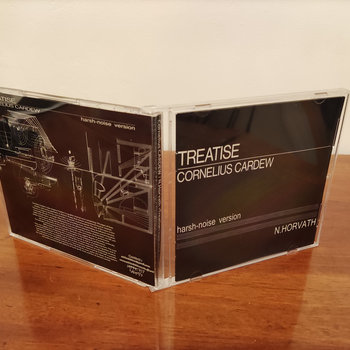


Compact Disc (CD)


However, complete Treatise recordings remain few and far between, for good reason. Spending just a minute on each of its 193 pages would take nearly three hours from start to finish. (That hasn’t cowed some people—experimental artist nsnn’s partial reading on Bandcamp spends between 17 minutes to an hour per page.) To self-impose some parameters and keep their interpretations manageable, some musicians split up the score so each page is performed for the same duration. Nagy and Jendon’s Treatise project, which took four years to record, limits each page to five minutes. The first complete commercial recording in 1999, coordinated by Chicago-based writer and editor Art Lange, also spent the same amount of time on each page: a little more than 40 seconds. That interpretation uses Treatise’s “lifeline” to help divvy up the score: Jim O’Rourke and Jim Baker, on electronics and keyboards respectively, play material below the line, while cellist Fred Lonberg-Holm and reedist Guillermo Gregorio play anything above it. The exception was curved and circular material anywhere on the page, which became percussionist Carrie Biolo’s domain.
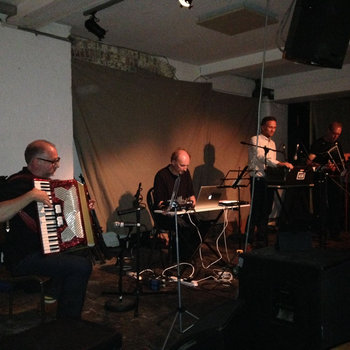
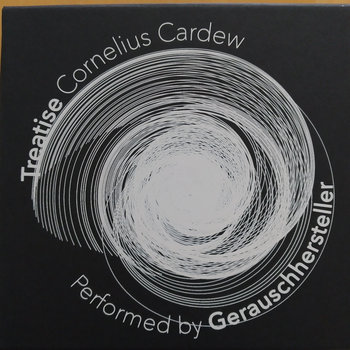
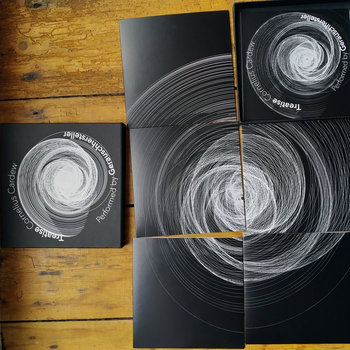
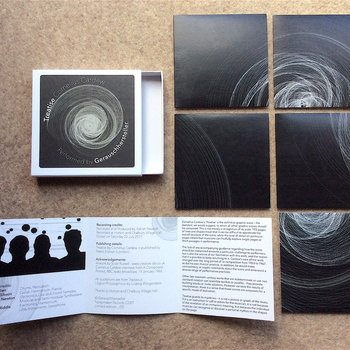
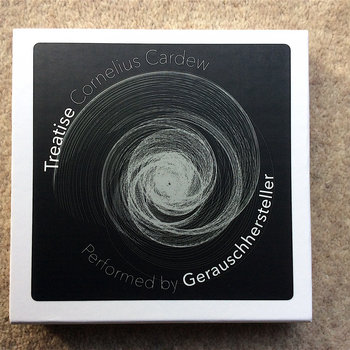

Compact Disc (CD)




Timed to the 50th anniversary of Treatise’s completion, a five-CD recording by the UK-based ensemble Gerauschhersteller takes a different approach, treating the “lifeline” like a timeline for tracking the 90 seconds allotted for each page. From there, musicians Paul Allen, Steve Gibson, Adrian Newton, and Stuart Riddle developed their own individual rules for interpreting Treatise’s graphic elements, mixing acoustic and electronic elements in a transcendental, unremittingly articulate rendition.
Yet another anniversary release by the London Experimental Ensemble enlists larger forces—13 musicians—and offers a fascinating point of comparison. Taken from a live 2017 performance which projected the score behind the musicians, the recording claims some direct ties to Cardew: The ensemble grew out of improvisation workshops run by Cardew’s former AMM bandmate Eddie Prévost and features Carole Finer, a founding member of the Scratch Orchestra, on the Turkish stringed cümbüş and found objects.
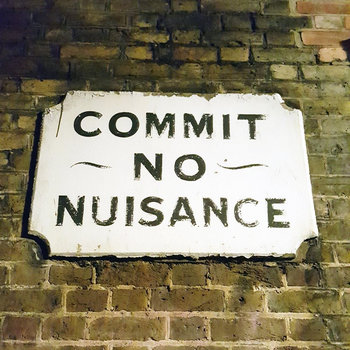
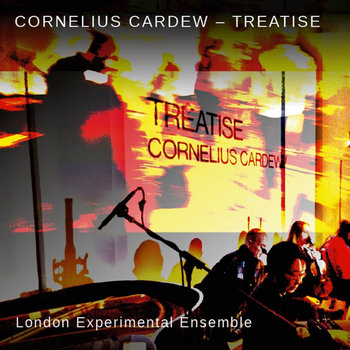

Compact Disc (CD)

Easily, Treatise stands as the most performed work of Cardew’s career and remains, arguably, his best-known work. But just as Wittgenstein distanced himself from Tractatus, Cardew later repudiated Treatise entirely. The composer eventually funneled his musical attention towards communist organizing, shunning projects he deemed apolitical or insufficiently supportive towards the cause. His Scratch Orchestra, which at first embraced its internal factions, soon buckled under the weight of political polarization.
In 1974—the same year the Scratch Orchestra played its final program, of the revolutionary songs and arrangements Cardew had by that point pivoted to—Cardew wrote the polemic Stockhausen Serves Imperialism. In it, Cardew disavowed his titular former mentor, Cage, and Treatise. He’d come to believe the score had become an obstacle, not a path, to musical expression and called it “contradictory and incoherent, like the words of a liar who has lost all hope of deceiving his audience,” he wrote. He continued: “Happily for my peace of mind Treatise has not been so successful, and I am treating it merely as a test case.”
When Cardew died in 1981, the victim of an unsolved hit-and-run under circumstances that are still hotly debated, he had no idea how starkly the ensuing years would prove him wrong. Far from being creatively stifling, Treatise continues to inspire a wealth of perspectives and spirited discourse well into its sixth decade—just as Cardew originally intended.







